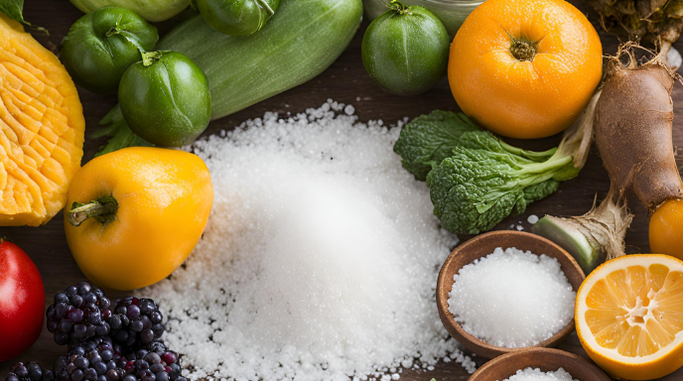Fruits and vegetables are essential to a healthy diet, but they can spoil quickly, leading to food waste and loss of nutrients. Salt, a natural preservative, has been used for centuries to extend the shelf life of fresh produce, retain moisture, and prevent spoilage. Whether you're trying to preserve the freshness of your fruits and vegetables at home or extend their usability, salt can be a valuable tool in your kitchen. This post explores several ways to use salt to keep fruits and vegetables fresh longer.
1. Saltwater Solution for Washing and Soaking
One of the simplest and most effective ways to keep fruits and vegetables fresh is by using a saltwater solution for washing or soaking them. Saltwater can help kill bacteria and fungi on the surface of produce, which can contribute to faster spoilage.
How to Use:
- Mix 1 tablespoon of salt in a gallon of water to create a saltwater solution.
- Soak fruits and vegetables in the solution for about 5-10 minutes. Be sure to rinse them thoroughly afterward with fresh water to remove any remaining salt.
- This method works particularly well for berries, leafy greens, cucumbers, and tomatoes, helping to extend their shelf life by killing harmful bacteria and preventing mold growth.
Benefits: Saltwater soaking helps reduce the microbial load on the surface of produce, which can slow down spoilage. It also helps preserve the quality of delicate fruits like berries, which can start to mold quickly.
2. Salt for Pickling and Preserving
Pickling is one of the most popular and effective ways to preserve fruits and vegetables, and salt is a key ingredient in the pickling process. Salt draws out water from the produce, creating an environment where bacteria are less likely to thrive, thus preserving the food for months.
How to Use:
- Prepare a brine solution by dissolving salt in water. The salt concentration can vary depending on the recipe, but a typical ratio is 2-3 tablespoons of salt per quart of water.
- Pour the brine over your choice of fruits or vegetables (such as cucumbers, carrots, or green beans) in a jar. Seal the jar and let it sit at room temperature for several days, allowing the fermentation process to take place.
- Once the pickles have fermented to your liking, refrigerate them to slow down further fermentation and keep them fresh for several months.
Benefits: Pickling with salt not only extends the shelf life of fruits and vegetables, but it also enhances their flavor. The process of fermentation creates probiotics, which can benefit your digestive health.
3. Salt for Dehydration and Storage
Another method for preserving fruits and vegetables is dehydrating them. While salt isn’t required for dehydration, it can improve the process, especially for vegetables. Salt can help remove excess moisture from produce and prevent microbial growth during dehydration.
How to Use:
- Sprinkle salt lightly over vegetables such as tomatoes, zucchini, or eggplant before dehydrating them. The salt helps to pull out moisture, which reduces the risk of spoilage.
- After salting, let the vegetables sit for a few hours before placing them in a dehydrator or oven on a low temperature.
- Once dried, store your vegetables in airtight containers in a cool, dark place to keep them fresh for months.
Benefits: Salt helps the dehydration process by preventing the growth of mold and bacteria while also improving the flavor of the dried produce. This method works well for vegetables like tomatoes, mushrooms, and bell peppers.
4. Salt to Slow Browning of Cut Fruits
Cut fruits, particularly apples, pears, and avocados, tend to brown quickly due to oxidation. Salt can help prevent this by slowing down the browning process and maintaining the fresh appearance of the fruit.
How to Use:
- Dissolve 1/2 teaspoon of salt in a cup of water.
- Dip cut fruits like apples, pears, or avocados into the saltwater solution for a few seconds, or use a spray bottle to lightly coat the surface of the cut fruit.
- Rinse the fruit with fresh water before consuming or storing it.
Benefits: Salt helps to prevent enzymatic browning, which occurs when the cut surface of fruit reacts with oxygen in the air. This technique is especially useful for fruits that are being prepared in advance, like for salads or fruit platters.
5. Salt for Preserving Leafy Greens
Leafy greens like lettuce, spinach, and kale can be tricky to keep fresh, as they tend to wilt and spoil quickly. Salt can help extend the freshness of these delicate vegetables by reducing moisture and preventing microbial growth.
How to Use:
- Fill a large bowl with water and add 1 tablespoon of salt.
- Submerge leafy greens in the saltwater solution for 5-10 minutes. Then, rinse the greens thoroughly with fresh water to remove excess salt.
- Dry the greens using a salad spinner or by patting them dry with a clean towel.
- Store the greens in a sealed container with a paper towel to absorb any excess moisture.
Benefits: The saltwater wash helps prevent wilting and reduces the growth of bacteria that can cause spoilage. This method is especially helpful for greens that are stored in the refrigerator.
6. Salt for Storing Root Vegetables
Root vegetables like potatoes, carrots, and turnips can last longer when stored properly. Salt can help reduce moisture and bacteria growth, which can cause rot in root vegetables when stored for long periods.
How to Use:
- Lightly sprinkle salt over root vegetables like carrots or turnips before storing them. This can be done by packing them in a layer of salt in a cool, dry storage area.
- For potatoes, wrap them in paper towels or cloth and place them in a cool, dark spot to keep them fresh for longer.
Benefits: Salt helps to reduce moisture in root vegetables, which prevents them from becoming soft or rotting. It can also inhibit the growth of mold and bacteria that can lead to spoilage.
7. Salt to Preserve Tomatoes and Peppers
Tomatoes and peppers can be preserved with salt through drying or brining. This is particularly helpful when you have an abundance of fresh produce that you can’t use immediately.
How to Use:
- For brining, prepare a saltwater solution (as in pickling) and submerge your sliced tomatoes or peppers in the brine.
- Alternatively, you can dehydrate them by sprinkling salt over sliced tomatoes or peppers and then drying them in a dehydrator or oven.
Benefits: Brining and salting tomatoes and peppers help preserve their flavor and texture while preventing spoilage. Dried tomatoes and peppers can be stored for months and rehydrated as needed for cooking.
Conclusion
Salt is a versatile and effective tool for preserving the freshness of fruits and vegetables. From soaking in saltwater solutions to pickling, salting for dehydration, and preventing browning, salt offers a natural, safe way to extend the shelf life of your produce and reduce food waste. By incorporating salt into your preservation methods, you can keep your fruits and vegetables fresh for longer, enjoy them year-round, and add a little extra flavor to your dishes. Whether you’re preserving the summer harvest or keeping your produce fresh for a busy week ahead, salt is a natural solution worth considering.




